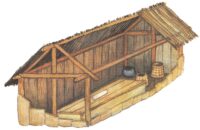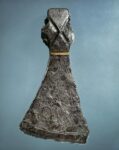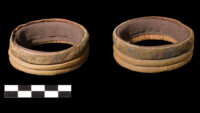The skeletal remains of a Viking aristocrat unearthed at the Bjerringhøj mound in Jutland in 1868 have been rediscovered after more than a century spent in a mislabeled box in the National Museum of Denmark.
 Located in the village of Mammen, the mound was first dug up by the landowner as fill to level a depression. He and his buddies stripped the topsoil and exposed the central grave: a wooden chamber grave replete with precious objects which they happily helped themselves to and showed off in the village. Arthur Feddersen, a fishery professor at the Viborg Cathedral School with a passion for archaeology, heard about the find and went to the site. The farmers had scattered everything that they weren’t interested in looting — textile fragments, bones, feathers — leaving nothing in situ. He interrogated them to document as much as possible about the structure of the grave and its goods and a subsequent survey recorded what was left of the burial. The grave goods were eventually reclaimed from the villagers and sent to the National Museum of Denmark.
Located in the village of Mammen, the mound was first dug up by the landowner as fill to level a depression. He and his buddies stripped the topsoil and exposed the central grave: a wooden chamber grave replete with precious objects which they happily helped themselves to and showed off in the village. Arthur Feddersen, a fishery professor at the Viborg Cathedral School with a passion for archaeology, heard about the find and went to the site. The farmers had scattered everything that they weren’t interested in looting — textile fragments, bones, feathers — leaving nothing in situ. He interrogated them to document as much as possible about the structure of the grave and its goods and a subsequent survey recorded what was left of the burial. The grave goods were eventually reclaimed from the villagers and sent to the National Museum of Denmark.
 From surviving fragments we know the deceased was richly clad in woolen garments decorated with purple and red silk and red and blue embroidery. He wore two cape bands, padded silk cuffs decorated with bands of silk, silver and gold threads, which survived the crude excavation in good condition. The individual had been laid to rest on down bedding in a wooden coffin, and the coffin placed inside a wooden chamber grave sealed with blue clay. Two iron axes were at his feet, one of them decorated with intricate silver inlay which was the first of its kind ever found and whose decorative motif is now known as Mammen style. Atop the coffin was a bronze bucket, two wood buckets a wax candle almost two feet long which may be an indication that the deceased was Christian.
From surviving fragments we know the deceased was richly clad in woolen garments decorated with purple and red silk and red and blue embroidery. He wore two cape bands, padded silk cuffs decorated with bands of silk, silver and gold threads, which survived the crude excavation in good condition. The individual had been laid to rest on down bedding in a wooden coffin, and the coffin placed inside a wooden chamber grave sealed with blue clay. Two iron axes were at his feet, one of them decorated with intricate silver inlay which was the first of its kind ever found and whose decorative motif is now known as Mammen style. Atop the coffin was a bronze bucket, two wood buckets a wax candle almost two feet long which may be an indication that the deceased was Christian.
 Dendrochronological analysis of wood recovered during a 1986 re-excavation revealed the man was buried in the winter of 970-1 A.D., during the reign of King Harald Bluetooth, first Christian king of Denmark who had converted in the 960s. The Bjerringhøj burial is one of the greatest finds of the Viking era. It has the largest textile assemblage ever found in a Danish Viking grave and the greatest quantity of silk ever found in a Danish Viking grave. The richness of the furnishings suggest the deceased was a high-ranked aristocrat in the circle of the king himself, perhaps even a member of the royal family.
Dendrochronological analysis of wood recovered during a 1986 re-excavation revealed the man was buried in the winter of 970-1 A.D., during the reign of King Harald Bluetooth, first Christian king of Denmark who had converted in the 960s. The Bjerringhøj burial is one of the greatest finds of the Viking era. It has the largest textile assemblage ever found in a Danish Viking grave and the greatest quantity of silk ever found in a Danish Viking grave. The richness of the furnishings suggest the deceased was a high-ranked aristocrat in the circle of the king himself, perhaps even a member of the royal family.
 His elite status could not protect his remains from falling down the storage hole, however. There was very little written about the bones at the time of the discovery. The only extant description of them is a brief paragraph from 1872 declaring the surviving right radius, right ulna, right foot and one molar were from an adult. Sex could not be determined, and then the bones went missing so subsequent researchers were unable to analyze them to learn more about the deceased despite several attempts to locate them over the years.
His elite status could not protect his remains from falling down the storage hole, however. There was very little written about the bones at the time of the discovery. The only extant description of them is a brief paragraph from 1872 declaring the surviving right radius, right ulna, right foot and one molar were from an adult. Sex could not be determined, and then the bones went missing so subsequent researchers were unable to analyze them to learn more about the deceased despite several attempts to locate them over the years.
The bones were rediscovered by accident as part of a project investigating textiles found in elite Danish Viking graves, the Bjerringhøj textiles among them. Researchers found the bones in a box labelled “Slotsbjergby,” site of another Viking Age burial found on Zealand in 1897. Bones were unearthed at Slotsbjergby, but fragments of textiles attached to the ones in this box matched the Bjerringhøj textiles, not Slotsbjergby’s.
The extant remains include the shafts of the right humerus and right ulna, the lower part of a right radius, and the trapezium and the trapezoid from the right wrist. From the lower body, the shafts of the right and left femora are present, along with the broken distal end of the left femur, a fragment of an unsided patella, a right tibia with a broken proximal epiphysis, a fragment of the left tibia shaft, the shafts of the right and left fibulae, and a fragment of the right calcaneus.
All the bones mentioned in the 1872 report are present — right humerus and ulna, lower right radius, right wrist bones, right heel — except for the fragment of molar which is probably lost for good. Also in the box are the shafts of the right and left femora, a fragment of patella, a right tibia, a fragment of the left tibia shaft and the shafts of the right and left fibulae.
 Another key piece of evidence that these are the bones retrieved from the Bjerringhøj burial are the fragments and imprints of textiles preserved on the right tibia, femora and fibulae. A piece of twill on the right tibia is an exact match for an embroidered textile from Bjerringhøj. A little further up on the same tibia are two rolls of cloth identical to the rolled padding inside the pair of cape bands.
Another key piece of evidence that these are the bones retrieved from the Bjerringhøj burial are the fragments and imprints of textiles preserved on the right tibia, femora and fibulae. A piece of twill on the right tibia is an exact match for an embroidered textile from Bjerringhøj. A little further up on the same tibia are two rolls of cloth identical to the rolled padding inside the pair of cape bands.
Unfortunately the bones are not in good enough condition for DNA retrieval and without the long bones and pelvis sex and age are still hard to determine. Measurement suggests the deceased was male and older than 30 years, but there could also be a mixture of bones from two individuals as the right radius and heel bone are more gracile, so from a more petite individual, either younger or female.
The study had been published in the journal Antiquity and can be read in its entirety here.
Apparently, we have a Viking here with –well– what seems to be a hurting butt :no:
“In addition, there is pronounced bone proliferation and evidence for inflammation at the insertion sites for the gluteus maximus muscle on both femora (Figure 4b). As this muscle functions primarily during flexing and standing activities, such as stair climbing, standing from a sitting position or perhaps riding, the individual probably conducted this type of movement frequently.”
About Christianisation at around 1000 AD, some of their (pagan) royals were reburied in their first churches. However, to put that candle atop of the coffin may have been a way more affordable option. That axe with the silver inlay, on the other hand, just looks gorgeous.
:hattip:
PS: Unfortunately, plenty of Viking graves all around the Baltic Sea seem to be lost forever. I mean up to “500 burial mounds” in one single spot only, and not even in Scandinavia, is a lot:
—-
At the end of the 5th century there was an expansion from Gotland to the Eastern Baltic. While the inhabitants from the west of Schonen were mainly oriented to the west for their war campaigns, the inhabitants from the area around Lake Mälaren, Gotland, Öland and along the present-day east coast of Sweden mainly moved east to the Caspian Sea. They sought contact with Arab merchants and established trading posts in Novgorod, Staraya Ladoga and Kiev. In the 7th and 8th centuries there were significant colonies in Grobiņa (western Latvia), Suaslaukas near Liepāja in western Latvia, near Apuole in northwestern Lithuania, and in the area around Elbląg (Truso). This is also confirmed by Rimbert in his Vita Anskarii. Sagas from Scandinavia agree that in the 7th century Swedes under Ivar Vidfamne set out for the Baltic. This expansion lasted until about 800, when the Svear were expelled from Courland, maybe because their interest had shifted more to the west to the Curonian Lagoon and the mouth of the Memel, where Kaup (about 800 – 1000AD) has been excavated. Swedish settlements upstream of the Memel are also known. But around 850 a new wave of expansion began. The reconquest of Courland and the Eastern Baltic was started. However, the first advance was made by Danes in 855, but they were defeated by the Locals. Then King Olov followed, and he destroyed and pillaged Grobiņa and subjugated all of Courland. According to the findings, these settlements were trading colonies. Around that time, Scandinavians from Sweden advanced to Kiev and founded the Rus Empire. This expansion strongly differs from the westward expansion of the Norsemen in the North Sea because of its main orientation towards trade policy, in spite of warlike episodes. From Kiev, Varangians advanced to Constantinople around 860, but failed to conquer the city, as they did again in 907.
en.wikipedia.org/wiki/Kaup_(emporium) -so to speak as a counterpart to- en.wikipedia.org/wiki/Jomsvikings
—-
In a forest skirting the modern settlement, archaeologists found a large cemetery, consisting of up to five hundred tumuli. Of these, only a few remain: continuing activities of amateur Russian archaeologists approach vandalism in that they result in razing of several tumuli each summer. The finds unearthed at Kaup highlight Swedish rather than Danish connections of the medieval Scandinavian colonists. The tumuli are semi-spherical, less than 1 meter (3ft 3in) in height and ranging from 5 to 12 meters (16 to 39ft) in diameter. A huge boulder was placed on top of each barrow. Some burial mounds were surrounded by stone rings. The Vikings were cremated elsewhere, together with their swords and arrows, before ashes of the dead and their burnt weapons were deposited inside the barrows.